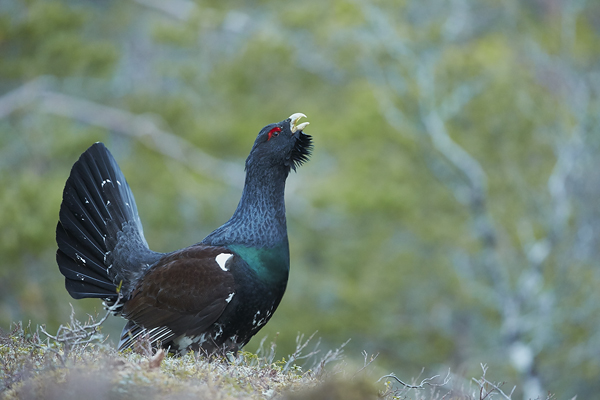Ask anyone who loves the avian world and has been fortunate to visit or photograph at the lekking site of any member of the Grouse family and I am sure they will all tell you that to greet the dawn of a new day with a displaying male (and sometimes many more) just outside your hide is right up there in terms of their experiences in the natural world. It certainly is among mine and although I have been fortunate enough to have many such experiences a week in the forests and mountains of Norway this Spring was as good as any – hard earned but ultimately right up there.
The undoubted king of the family in Europe is the Capercaillie, threatened and declining fast here in the UK due to the lack of suitable habitat, but still strong in the less developed spaces of Scandinavia. Finding the exact spot where they will choose to settle the disputed hierarchy of males and ultimately attract the females of the area though is a challenge and one I was as ever grateful to my good friend Ole Martin Dahle in helping with – the site where I have enjoyed working in the past had seen a change of top bird and after a few nights camped out awaiting a dawn visit, there seemed to be no pattern to where things were happening other than it wasn’t where I was! Upping sticks and moving to a more remote spot in search of a second site a further frustrating night followed with everything happening out of view, but a final adjustment and it was sixth night lucky as everything finally came together.
The dominant male always takes up his position early (around 2.30 am in this instance and having spent the previous couple of hours in a nearby tree) so for a good hour or so it is always a question of quietly looking through a crack in the dome hide window (everything is well covered for obvious reasons) and enjoying the sight and sounds as best you can. Eventually the light levels allow an image or two at high ISO’s (thank goodness for higher spec DSLRs) with single silent shot mode essential so as not to disturb things.
The spot where he had chosen to lek really couldn’t have been better mind – the very first rays of the rising sun fell perfectly on it as he continued about his posturing, making the iridescent nature of his feathers really shine when the angles were right.
Although there was another male hanging around in the area it is clear this guy was top dog, and it wasn’t too long before the females in the area started to gather, initially in the trees surrounding the lek site but eventually one of them dropped to the ground for a closer inspection.
His displaying reached a new level of frenzy before the mornings courting eventually came to an end.
Over the course of the next few days each and every one of the seven females that were around that morning will and did mate with this dominant male before retreating into their corner of the forest to lay their clutch and raise their brood of youngsters alone. The whole courtship process at the lek is a completely essential few days in the overall breeding success of the whole of this area of forest so simply to witness it, let alone photograph and experience it in a way that is sensitive to what is happening, is always a genuine privilege.
Having worked so long for this particular morning there was just time to enjoy a different lek site with a close relative of the Capercaillie – the more diminutive but considerably noisier Black Grouse. Although big lekking sites with several birds are often the norm, more isolated locations that attract lone birds who spend several days and weeks displaying for a mate seem to be more the norm in the coastal woodlands of central Norway, but this is no less engaging as a consequence. Black Grouse often appear after sunset for a late evening display and this was the case here – an 11pm visit in the dim light punctuated by the extraordinary set of calls that they make and which if you haven’t heard them before can be listened to here. Too dark to photograph he left after an hour only to return again around 3 am and once again it was a question of patiently enjoying the spectacle and taking the occasional image as the light continued to get better and better and better, initially on the distant background but eventually falling on the bird and lekking site too – note the frost on the ground in the early shots for a clue how cold it still is here overnight at this time of the year!
In the last of these images you can see him starting to leap into the air, an integral part of his amazing displays and given that he was entirely on his own in terms of both rivals and females too it says a great deal for his will power and persistence that he managed to keep this up for a good 2 hours in total!
Eventually he moved briefly off to a different area for a final check that he was on his own and then headed off for the day to return again that evening to continue his quest once more!
Nature offers some amazing sights, sounds and experiences and the Spring lek is definitely one of them for me and one I look forward to engaging all of my senses in again too.


















